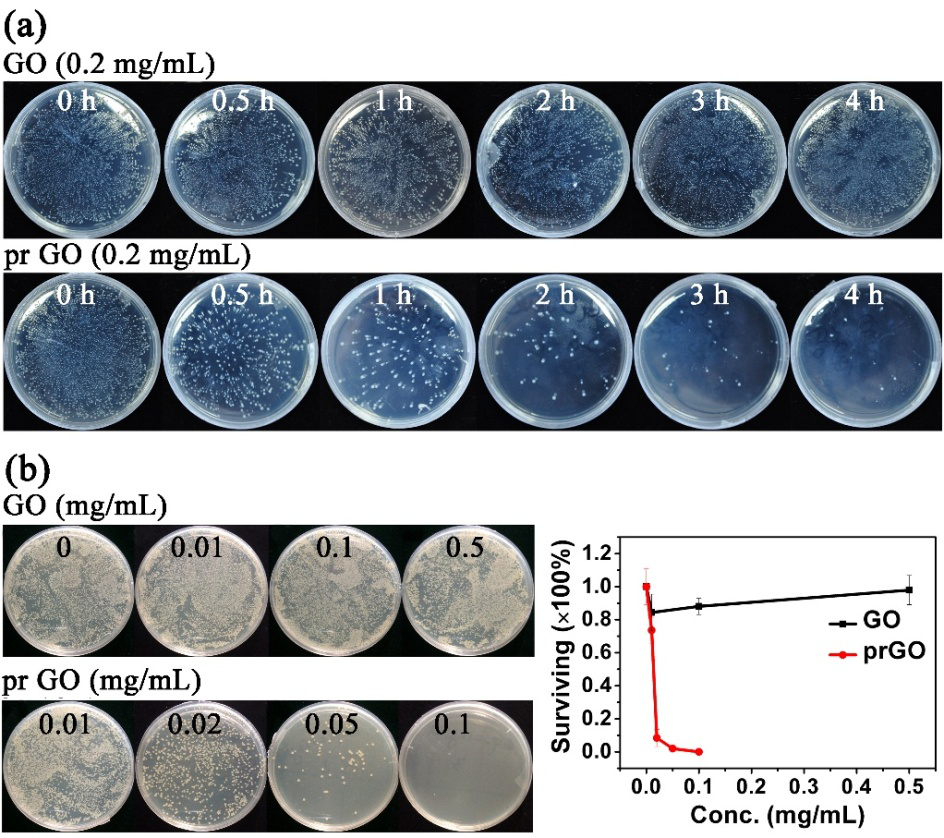
Recently, a research team led by Prof. HUANG Qing from Hefei Institutes of Physical Science, in cooperation with Dr. WANG Qi, found that non-thermal hydrogen plasma processing can effectively increase the antibacterial activity of graphene oxide (GO). Their work was published on Applied Physics Letters.
Graphene, as a new two-dimensional carbon material, has shown great potential application in many biomedical fields.
Recent studies showed that graphene-based materials have not only broad spectrum bactericidal ability, but also no essential bacterial resistance. However, compared with other traditional antibacterial drugs and chemicals, the antibacterial capability of graphene-based materials (GMs) is relatively low.
In order to improve the sterilization ability, it is usual to treat GMs by chemicals which however may put environment at potential risks of being polluted under mass use.
In this regard, the joint team tried to process the GMs by non-thermal plasma and investigated the improvement of antibacterial activity.
They treated the GO material with a home-made radio-frequency-driven inductively coupled hydrogen (H2) plasma device and found that the plasma-reduced GO (prGO) displayed significantly higher bactericidal activity against Escherichia coli (E. coli).
They found that prGO as low as 0.02mg/mL can inactivate 90% bacteria after incubation for 4 h, while GO even at 0.5mg/mL showed no comparable distinct effect on the bacterial inactivation at all.
To look at the underlying mechanism, the team characterized the GO and prGO with atomic force microscopy (AFM), Raman spectroscopy mapping, and X-ray photoelectron spectroscopy (XPS) measurements, and also compared the membrane damage of E. coli induced by GO with prGO using scanning electron microscope (SEM).
In this way, they found that the plasma processing not only reduced GO and decreased its size, but also generated several irregular defects on its surface such as "needles" and "knifes".
The generated defects led to severer damages to the bacterial membrane, and consequently the leakage of intracellular substances and bacterial death.
As such, this work has demonstrated that non-thermal plasma is an effective physical method for modification of GMs.
This work was supported by the Anhui Provincial Key Research and Development Plan, the National Nature Science Foundation of China, the Natural Science Foundation of Anhui Province, and also the Youth Innovation Promotion Association of the Chinese Academy of Sciences.

The characterization of GO and prGO with AFM, Raman (spectra and ID/IG mapping) and XPS measurements (Image by KE Zhigang)

Dependence of bacterial inactivaton by GO and prGO on exposure time (a) and on concentration, (b) the exposure time in b is 4 h. (Image by KE Zhigang)

86-10-68597521 (day)
86-10-68597289 (night)

86-10-68511095 (day)
86-10-68512458 (night)

cas_en@cas.cn

52 Sanlihe Rd., Xicheng District,
Beijing, China (100864)

